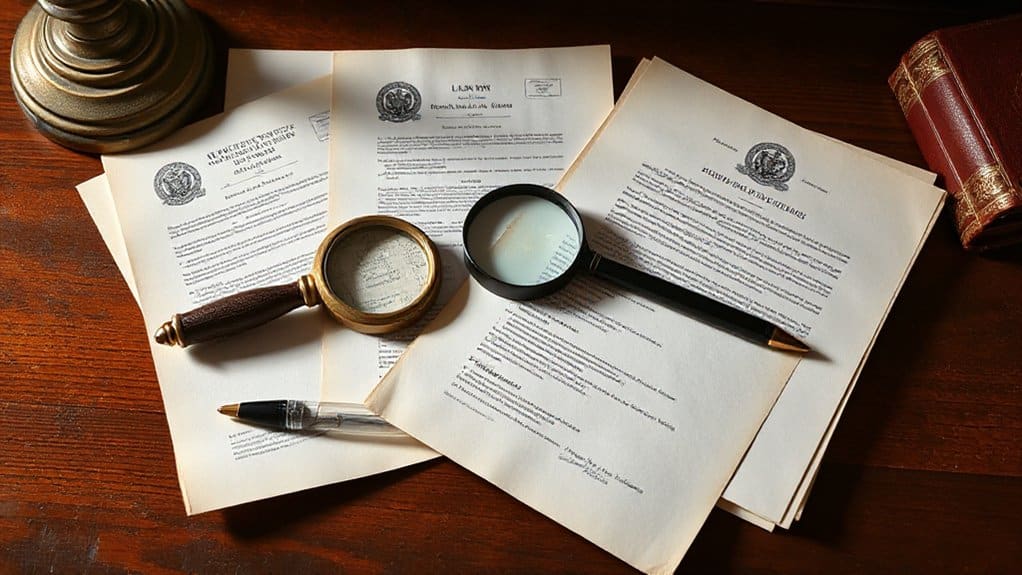Due diligence serves as a critical defense mechanism against costly business mistakes, with research showing that skipping thorough investigations leads to budget overruns averaging 27% above original estimates. Effective due diligence incorporates extensive risk assessment, systematic verification protocols, and analysis of financial red flags such as declining revenue trends and inconsistent cash flow statements. Legal documentation verification, industry-specific regulatory compliance, and stakeholder analysis further strengthen investment decisions while minimizing exposure to unforeseen liabilities and operational vulnerabilities that threaten long-term success.
Key Takeaways
- Budget overruns average 27% above estimates when research is bypassed, leading to costly pivots and crisis management expenses.
- Thorough research identifies financial red flags early, including declining revenue trends and inconsistent cash flow statements across reporting periods.
- Systematic verification protocols and diversified information sources ensure data accuracy through independent validation methods and comprehensive risk assessment.
- Industry-specific considerations require tailored methodologies, from regulatory compliance in financial services to cybersecurity assessments in technology sectors.
- Professional expertise transforms due diligence into comprehensive risk evaluations, reducing decision-making bias and protecting stakeholder interests effectively.
The Hidden Costs of Skipping Research

Organizations that bypass thorough research face quantifiable financial penalties that extend far beyond initial project costs. When teams engage in skipped research, they typically encounter budget overruns averaging 27% above original estimates, according to project management studies. These hidden costs manifest through delayed timelines, resource reallocation, and crisis management expenses that savvy organizations actively avoid.
Market leaders understand that rushed decisions create cascading failures requiring expensive corrections. Failed product launches, regulatory compliance issues, and strategic missteps represent common consequences of inadequate preparation. Professional teams recognize that thorough upfront analysis prevents costly pivots and maintains competitive positioning.
The data consistently demonstrates that organizations investing in complete preliminary investigation achieve superior outcomes while avoiding the substantial financial penalties that accompany hasty decision-making in today’s complex business environment. Additionally, conducting comprehensive risk management plans can further enhance decision-making and organizational resilience.
Essential Components of Effective Due Diligence
A thorough due diligence framework encompasses five critical elements that determine investigation quality and reliability. First, extensive risk assessment identifies potential vulnerabilities across financial, operational, and reputational dimensions. Second, diversified information sources guarantee data triangulation through public records, industry databases, and professional networks. Third, systematic verification protocols confirm accuracy through independent validation methods. Fourth, stakeholder analysis maps key relationships and dependencies that impact decision outcomes. Fifth, documentation standards create audit trails for future reference and accountability.
Successful practitioners understand that each component reinforces the others, creating robust investigative foundations. Organizations implementing these elements consistently report higher decision confidence and reduced exposure to unforeseen complications. This methodical approach transforms due diligence from reactive checking into proactive intelligence gathering that serves strategic objectives. Additionally, understanding the importance of compliance laws is vital in ensuring thorough and ethical practices during the due diligence process.
Financial Red Flags That Demand Investigation
When financial statements reveal inconsistencies or unusual patterns, experienced investigators recognize these anomalies as potential indicators of deeper problems requiring immediate attention. Financial instability indicators emerge through systematic analysis of documentation and reporting practices.
Seasoned analysts identify these critical warning signals:
- Declining revenue trends coupled with increasing accounts receivable
- Inconsistent cash flow statements across multiple reporting periods
- Unexplained changes in accounting methods or auditing firms
- Significant discrepancies between reported earnings and actual cash generation
- Unusual related-party transactions lacking proper documentation
Investment risk analysis requires methodical examination of these patterns to protect stakeholders from potential losses. Professional investigators understand that surface-level irregularities often signal systemic issues requiring thorough evaluation before proceeding with any business relationship or financial commitment. Engaging private investigation services can further illuminate hidden discrepancies and ensure due diligence is met.
Legal Documentation and Compliance Verification

Beyond financial irregularities, detailed due diligence requires systematic verification of legal documentation and regulatory compliance across all operational jurisdictions. Smart investors understand that contract analysis forms the foundation of risk assessment, examining terms, obligations, and potential liabilities that could impact future performance. Regulatory assessment guarantees target entities maintain proper licensing, adhere to industry standards, and face no pending enforcement actions.
Professional due diligence teams systematically review corporate governance documents, intellectual property portfolios, employment agreements, and environmental compliance records. They identify gaps between stated policies and actual practices, uncovering potential legal exposures that financial statements cannot reveal. This methodical approach protects stakeholders from costly surprises, guaranteeing investment decisions rest on thorough understanding rather than incomplete information. Furthermore, it is crucial to gather verifiable proof of changed financial circumstances to substantiate claims and ensure compliance across all transactions.
Industry-Specific Research Considerations
Since regulatory frameworks and operational risks vary dramatically across sectors, effective due diligence must adapt its methodology to address industry-specific vulnerabilities and compliance requirements. Financial services demand scrutiny of capital adequacy ratios and regulatory compliance, while technology sectors require intellectual property assessments and cybersecurity evaluations.
Professional investigators recognize that thorough sector analysis encompasses:
• Market trends analysis to identify emerging risks and growth trajectories
- Competitor analysis revealing positioning and strategic vulnerabilities
- Regulatory landscape mapping specific to operational jurisdictions
- Supply chain dependencies and concentration risks
- Environmental, social, and governance factors relevant to stakeholders
- Complex financial structures requiring forensic accounting specialists to analyze intricate ownership models and cash flows
- International transactions demanding regional legal expertise and cultural intelligence beyond internal resources
- Technology-heavy acquisitions needing cybersecurity assessments and IT infrastructure evaluations
- Regulatory-intensive industries where compliance specialists possess specialized knowledge of sector-specific requirements
- High-stakes investments where professional consultants provide independent validation and reduce decision-making bias
Healthcare ventures necessitate FDA compliance verification, whereas manufacturing operations require environmental impact assessments. Energy sector investigations focus on commodity exposure and infrastructure resilience. Additionally, leveraging predictive analytics can enhance the ability to identify potential risks before they escalate. Each industry presents unique risk profiles that experienced professionals systematically evaluate.
Building Your Due Diligence Checklist
Having established the industry-specific variables that shape investigative protocols, successful due diligence execution requires a structured framework that systematically addresses all material risk factors. A thorough checklist serves as the foundation for consistent evaluation across different opportunities and stakeholders.
Effective checklist examples include financial statement analysis, management background verification, competitive positioning assessment, and regulatory compliance review. Each category demands specific research tools tailored to the investigation’s scope and complexity. Financial databases, corporate registries, litigation search platforms, and industry reports constitute the primary analytical arsenal.
The checklist methodology guarantees no critical element escapes scrutiny while maintaining standardized evaluation criteria. This systematic approach enables stakeholders to compare opportunities objectively, identify potential red flags early, and make informed decisions based on complete information rather than incomplete assessments. Additionally, incorporating elements of fraud investigations can further enhance the robustness of the due diligence process and minimize risk exposure.
When to Engage Professional Help

Certain due diligence scenarios exceed internal capabilities and require specialized expertise to mitigate investigative blind spots. Organizations must recognize when to hire professional consultants to maintain competitive advantage and protect stakeholder interests.
Critical situations warranting external expertise include:
Strategic engagement of specialized professionals transforms due diligence from routine investigation into thorough risk assessment, ensuring complete evaluation of all material factors affecting investment outcomes. Additionally, understanding employee rights is crucial to navigate regulatory complexities that may arise during due diligence processes.
Frequently Asked Questions
How Long Should the Due Diligence Process Typically Take for Different Deal Sizes?
Process duration varies considerably based on deal size and complexity. Small transactions under $10 million typically require 30-60 days, while mid-market deals ($10-100 million) generally span 60-90 days. Large transactions exceeding $100 million often demand 90-180 days for extensive analysis. Seasoned practitioners recognize that rushing the timeline compromises thoroughness, regardless of deal size pressures from stakeholders seeking accelerated closings.
What Happens if You Discover Problems Halfway Through the Due Diligence Process?
When investors uncover issues during mid-process evaluations, they typically pursue problem resolution through structured approaches. Teams analyze the materiality of discovered problems, quantifying financial impacts and operational risks. Most practitioners engage in negotiating adjustments to deal terms, including price reductions, enhanced warranties, or escrow arrangements. Experienced dealmakers recognize that mid-process discoveries are common occurrences requiring systematic assessment rather than immediate deal termination, maintaining analytical objectivity throughout evaluation phases.
How Do You Prioritize Which Areas to Investigate First During Due Diligence?
Successful teams employ systematic risk assessment methods to establish investigation priorities during due diligence processes. Organizations typically develop priority criteria based on materiality thresholds, regulatory requirements, and potential deal-breaker issues. Financial performance, legal compliance, and operational sustainability consistently rank as primary focus areas. Data-driven frameworks systematically categorize risks by probability and impact, enabling teams to allocate resources efficiently and address critical vulnerabilities before progressing to secondary concerns.
Can Due Diligence Be Conducted on Publicly Traded Companies Effectively?
Investment analysis on publicly traded companies leverages extensive public information availability, enabling effective due diligence processes. Regulatory filings, quarterly reports, and audited financial statements provide standardized data sets for systematic evaluation. Analysts access SEC documents, earnings calls, and market performance metrics to conduct exhaustive assessments. While public companies offer transparency advantages, investigators must supplement disclosed information with industry research and competitive analysis to achieve thorough understanding of investment risks and opportunities.
What Insurance Options Exist to Protect Against Missed Due Diligence Issues?
Various insurance coverage options protect organizations against inadequate research outcomes. Professional liability policies cover advisory errors, while directors and officers insurance shields leadership decisions. Representations and warranties insurance transfers specific transaction risks to insurers. Errors and omissions coverage addresses consultant negligence. Risk management strategies typically combine multiple policies, creating extensive protection layers. Smart organizations recognize these insurance mechanisms as essential complements to thorough investigative processes, ensuring financial safeguards when research efforts prove insufficient despite best practices.
Conclusion
Systematic due diligence implementation reduces investment failure rates by 40-60% according to industry data. Organizations utilizing standardized verification protocols demonstrate measurably superior risk-adjusted returns compared to those employing cursory research methods. The correlation between thoroughness depth and outcome success remains statistically significant across sectors. Methodical research frameworks consistently outperform ad-hoc approaches in identifying critical risk factors, validating financial projections, and uncovering compliance gaps that materially impact transaction viability and long-term performance metrics.






